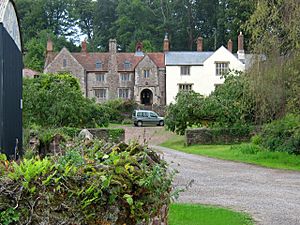William Dorrington facts for kids
Quick facts for kids
William Dorrington
|
|
|---|---|

Dodington Hall, Somerset, ancestral home of the Dodington or Dorrington family; heraldic evidence suggests William Dorrington was a member
|
|
| Born | c.1644 England |
| Died | 11 December 1718 Paris, France |
| Allegiance | |
| Service/ |
Infantry |
| Years of service | c.1675-1718 |
| Rank | Lieutenant General |
| Unit | Royal Irish Regiment of Foot Guards |
| Battles/wars | Williamite War in Ireland: |
William Dorrington (around 1644–1718) was an English army officer. His name was sometimes spelled "Dorington" or "Dodington."
He was a Roman Catholic during a time when Catholics faced limits on military service in England. Dorrington is best known for supporting the Jacobite cause of King James II. He was especially connected with the Royal Irish Regiment of Foot Guards. He became a Major General in James's Irish Army and fought in the Williamite War.
Dorrington was known as a skilled soldier. Later in his career, he held a high rank in the French army. He also received the title of Earl of Macclesfield from the Jacobite Peerage. His Foot Guards regiment later became the Regiment Roth in the Irish Brigade.
Contents
Early Military Career
We don't know much about William Dorrington's early life. His family's coat of arms, which showed three bugle horns, was the same as the Dodington or Dorington families from Somerset and Wiltshire. These families were strong supporters of the King during the English Civil War.
Starting in 1675, Dorrington gained experience as a Captain. He served in a regiment of Anglo-Irish volunteers. These soldiers fought with the French Army of Louis XIV against the Dutch. From 1678 to the mid-1680s, he was an officer in the English Army during peacetime.
Service in Ireland
William Dorrington was quickly promoted after King James II came to power. By 1685, he had joined the Irish Army. He became a major in Thomas Fairfax's regiment. In 1686, he was made Lieutenant Colonel of the Royal Irish Regiment of Foot Guards. This was a very important and respected unit.
Dorrington was deeply involved in removing Protestant officers from the army. This process began after 1685 and sped up in 1687. He was even accused of being "too fast" in replacing his regiment with Catholic soldiers.
Dorrington stayed loyal to King James during the Glorious Revolution of 1688. Many senior officers in England joined William of Orange's invading army. The Irish Army, led by the Earl of Tyrconnell, prepared to defend Ireland for King James. Jacobite loyalists from England and Scotland also joined them.
Dorrington officially became the colonel of the Foot Guards. He replaced the Protestant Duke of Ormonde. Eventually, he became one of six Major-Generals in the Jacobite army. His reputation as a soldier was so high that when he arrived at the Siege of Derry, his presence was used to try and scare the defenders.
He was wounded at Derry, but not badly. He also fought in the Battle of the Boyne the next year.
After the Siege of Limerick
After the Jacobite victory at the Siege of Limerick, Dorrington was made Governor of the city. This success made some Jacobites believe they could still win the war. Dorrington and Patrick Sarsfield were key figures in the "War Party." This group did not want to make peace with William.
The 1691 campaign started with a short but bloody siege at Athlone. The Williamite army took the town. The main Jacobite force then retreated along the Galway road. The two armies met at Aughrim, County Galway on July 12. Dorrington and John Hamilton led the two divisions of Jacobite infantry.
The Battle of Aughrim ended with the Jacobite forces being defeated. Hamilton was badly wounded, and Dorrington was captured. The Williamite commander, Ginkel, had promised Dorrington that captives would be treated as prisoners of war. However, Dorrington and other generals were taken to the Tower of London as state prisoners instead.
Dorrington was held in the Tower of London. In late 1693, he complained about his treatment. He was not given the rights usually given to prisoners of war. In February 1694, he successfully escaped from the Tower. He was disguised and helped by some Jacobite supporters. The London Gazette offered a £300 reward for his capture. They described him as "a tall spare Man, aged near 50 or thereabouts, thin Visaged, having a Welt near the lower part of his Right Cheek by a Shot."
Later Career in France
After escaping, William Dorrington returned to France. He took command of the Foot Guards again. They were now serving in exile under the terms of the Treaty of Limerick.
Dorrington then served in Flanders during the War of the Grand Alliance. He was promoted to brigadier on April 28, 1694. After the Peace of Ryswick ended the war, the Foot Guards joined the Irish Brigade of the French Army. This unit became known as Dorrington's Regiment.
He was made Major General in 1702. During the War of the Spanish Succession, he served in Germany. He was present at Blenheim in 1704. Later that year, he was promoted to Lieutenant General. He fought in the Battle of Ramillies in 1706 and at Malplaquet in 1709.
He also went with King James's son, James Francis Edward, to Scotland. This happened during the failed 1708 landing attempt and the Jacobite rising of 1715.
In 1716, Dorrington was given the title of Earl of Macclesfield in the Jacobite Peerage. This title was not recognized in Britain. He died in Paris in 1718. His nephew's descendants continued to live in France until the 1800s.
Images for kids


